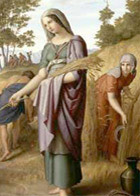Book of Ruth

The biblical book of Ruth, read later this week on the holiday of Shavuot, works in brief, gentle strokes to limn a powerful story of loss, recovery, and redemption. The story takes place in harvest season, in a prosaic world in which the actions of divine providence are coterminous with the yield of human goodness. "This scroll speaks neither of impurity nor purity, neither of forbidden nor permitted," says a famous midrash. "And why was it written? To teach you how great is the reward of those who mete out lovingkindness" (Midrash Ruth Rabbah 2:16).
The theme asserts itself in the book's opening. A truncated family of three widows, an older woman and her two daughters-in-law, has traveled from Moab to the outskirts of Bethlehem. Naomi, the older woman, urges the younger ones, Orpah and Ruth, to turn back and start their own lives. Orpah goes, but Ruth delivers a stunning declaration: "Do not urge me to leave you, to turn back and not follow you. For wherever you go, I will follow; wherever you live, I will live; your people will be my people and your God my God. Where you die I will die, and there will I be buried" (1:16–17).
This speech of Ruth's has become the fundamental template of conversion to Judaism: the act of casting one's lot with the community of Israel in its bodily existence and its spiritual journeys, in life and death. Whenever the book was written—scholarly opinions differ—its depiction of King David's great-grandmother as a daughter of Moab, one of ancient Israel's bitterest enemies, is breathtaking. As the contemporary interpreter Avivah Zornberg points out, these simple, daring words, uttered by a young woman who boldly proceeds to act on them, shatter what until then had been an impermeable barrier of Israelite law, thus reshaping the law and Jewish history at once.
As for Orpah, the daughter-in-law who turned away, Jewish tradition was unforgiving, portraying her as a harlot and worse, and as the mother of none other than Goliath. In 1934, the poet Chaim Nachman Bialik, watching the world scene darken, gathered together a group of Orpah legends in a brief, savage text, "The Scroll of Orpah," asserting an eternal divide between virtuous and evil Gentiles. In recent years, some feminist interpreters have attempted to find a place for this seemingly wayward daughter.
And why is Ruth read on Shavuot? The 13th-century Sefer Hamanhig, a treasury of law and custom, offers two reasons. Shavuot is, after all, a celebration of the spring harvest, when the story is set. But Shavuot also commemorates the giving of the Torah on Mount Sinai. Just as Ruth was a convert, so were all the Israelites present at that event: "indeed, Israel underwent conversion on receiving the Torah." And that experience of conversion, like the receipt of the Torah itself, was not a one-time event. Each generation and each individual must renew the covenant with Jewish fate and destiny—the same covenant clasped by the young Moabite woman who entered and regenerated the community through sheer goodness and courage.
It demonstrates marriage as a family obligation. There are male members of the family in Naomi's hometown of Bethlehem who have an obligation to fulfill the obligation of levirate marriage, and it ends up with Boaz, a wealthy member of that family falling in love with Ruth, marrying her, and this love comes during the harvesting in Boaz's fields, certainly an idyllic setting, and from that union they became the great grandparents of King David. So the king whose line is still recognized as the lineage of the King of Israel came from a foreign woman whose people, the Moabites, were reviled by ancient Israel. Moabites were considered the offsprings of Lot's incestuous relationship with one of his daughters after their escape from Sodom. (Both Lot and Abraham are related to Terah, so we're looking at one very large extended family.)
Furthermore, we are told in the Exodus account (Exod. 12:38, Num. 11:4, etc.) that a "mixed multitude" of other slaves seeking freedom and even other Egyptians came out of Egypt in the Exodus, and were associated each with a tribe and their descendants ended up numbered amongst them. In fact, the rituals and basic rules regarding the process of conversion are laid down in the Torah account of the Exodus, in Exod. 12:43-48, in the context of explaining the laws of Passover sacrifice and who may participate in the Passover feast. We name the weekly Torah portion that tells of the arrival of the Jews at Mt. Sinai (Exod. 18-20) after Moses' father-in-law Yethro, because he is accounted the first convert to Judaism as such and he foreshadows the conversion of the entire B'nai Yisrael to full Judaism at Mt. Sinai.
As the books of Joshua and Judges, and later historical books, also tell us, the Jewish people who settled in Canaan ended up intermarrying with the local inhabitants, and the entire population, under the appeals and criticisms of the prophets and loyal scribes and priests, eventually Judaized and converted over the centuries despite the constant tendencies to Canaanitic polytheistic and idolatrous practices, so that when the inhabitants of the northern Kingdom of Israel were deported around 722 BCE, they were all deported according to II Kings 17 as Jews, all as the Children of Israel, the people of the Sinai covenant, and when the same happened in the southern Kingdom of Judah, again the entire population was deported as Jews, II Kings 25 -- also see the declarations and terminologies of the prophets before, during and after the Exile, Hosiah, Amos, Jeremiah, Isaiah, Zechariah, etc. Many of these speak of conversion to Judaism, by the way. So Ruth is not the first convert by any means. We are a convert people as such from the very beginning.
Comments are closed for this article.




